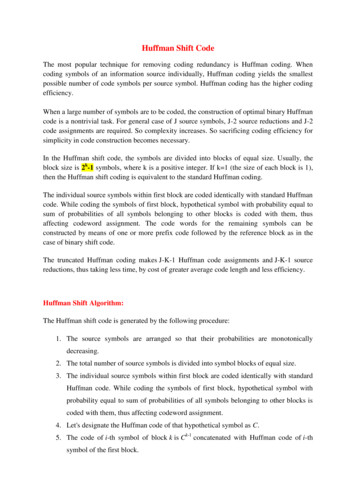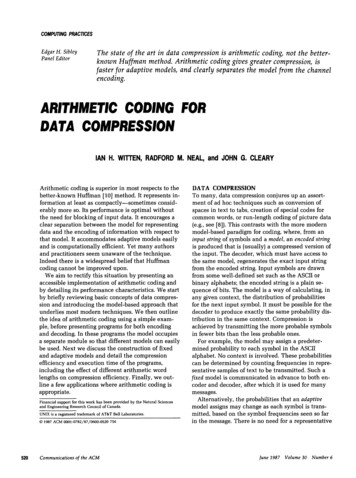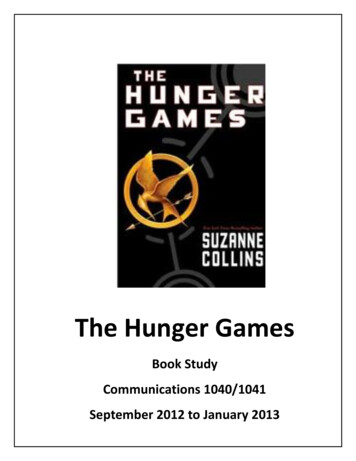
Transcription
Huffman Coding AssignmentFor CS211, Bellevue College (rev. 2016)(original from Marty Stepp, UW CSE 143, modified by W.P. Iverson)Summary:Huffman coding is an algorithm devised by David A. Huffman of MIT in 1952 for compressing text data to make a fileoccupy a smaller number of bytes. This relatively simple compression algorithm is powerful enough that variations of itare still used today in computer networks, fax machines, modems, HDTV, and other areas. The basic principle is toencode characters into a specialized tree structure, with specialized nodes. The complete description of Huffmancompression is below. Basically, we’re building a simple binary tree, where the node “data” is a count of the frequency ofeach character in the file to be compressed. And the tree of nodes is organized with the most frequent characters near theroot:public class HuffmanNode implements Comparable HuffmanNode {public int frequency;public char character;public HuffmanNode left;public HuffmanNode right;In order to build your Huffman Tree you need some basic methods for file I/O:public HuffmanTree(Map Character, Integer counts)// Constructorpublic StringBuilder compress(InputStream inputFile)// inputFile is a text filepublic StringBuilder decompress(StringBuilder inputString) //inputString 1’s & 0’spublic String printSideways()// as per the method presented in Chapter 17.The Huffman Node class also needs a boolean isLeaf() method, plus a static method to actually provide a count of thecharacters in an input file, and place those counts into a Map, with character as the unique key mapped into the integercounts of that character:public static Map Character, Integer getCounts(FileInputStream input)The Basic Idea:The input file to be compressed can actually be any format, but plain text will allow us to see what we’re doing withsimple ASCII characters. The output compressed file will a series of 1’s and 0’s (bits) as per the description below, whichtheoretically allows massive file compression. In practice, JAVA has some serious limitations here, so this assignment isonly for conceptual purposes. True file compression needs to be done in a low level language.Text data is stored in a standard format of 8 bits per character, commonly using an encoding called ASCII that maps everycharacter to a binary integer value from 0-255. The idea of Huffman coding is to abandon the rigid 8-bits-per-characterrequirement and use different-length binary encodings for different characters. The advantage of doing this is that if acharacter occurs frequently in the file, such as the letter 'e', it could be given a shorter encoding (fewer bits), making thefile smaller. The tradeoff is that some characters may need to use encodings that are longer than 8 bits, but this is reservedfor characters that occur infrequently, so that extra cost is not significant.1 of 5
The table below compares ASCII values of various characters to possible Huffman encodings for some unknown text file.The first step is to count the number of occurrences of each character in the text. Frequent characters such as space and'e' will have short encodings, while rare characters like 'z' have longer encodings.CharacterASCII valueASCII (binary)Huffman (binary)' 000100011010The steps involved in Huffman coding a given text source file into a destination compressed file are the following:1.2.3.4.5.Examine the source file's contents and count the number of occurrences of each character.Place each character and its frequency (count of occurrences) into a sorted "priority" queue.Convert the contents of this priority queue into a binary tree with a particular structure.Traverse the tree to discover the binary encodings of each character.Re-examine the source file's contents, and for each character, output the encoded binary version of that characterto the destination file.Encoding a File:Suppose we have a file named example.txt with the following contents (10 characters, so 10 bytes file size):ab ab cabIn the original file, this text occupies 10 bytes (80 bits) of data. The 10th is a special "end-of-file" (EOF) byte.bytecharASCIIbinary1'a'972'b'983' '324'a'975'b'986' /AIn Step 1 of Huffman's algorithm, a count of each character is computed. (i.e. the getCounts method). The counts arerepresented as a map:{' ' 2, 'a' 3, 'b' 3, 'c' 1, EOF 1}// Done back in an earlier chapter on sets and maps!Step 2 of the algorithm places these counts into binary tree nodes (Huffman Nodes), each storing a character and a countof its occurrences, with the left and right references all null (initially). These nodes are put into a priority queue(PriorityQueue HuffmanNode ()) which keeps them in sorted order with smaller counts at the front of the queue.front11233'c'EOF' ''b''a'backStep 3 (4, 5, .) is to repeatedly remove the front two nodes from the queue (the two with the smallest frequencies) andjoin them into a new node whose frequency is their sum. The two nodes are placed as children of the new node; the firstremoved becomes the left child, and the second the right. The new node is re-inserted into the queue in sorted order:front22' '1'n'a'b''c'33'b''a'back1EOFThis process is repeated until the queue contains only one binary tree node with all the others as its children. This will bethe root of our finished Huffman tree. Remember that each of the nodes above is the special Huffman Nodes we’veinvented for this assignment. The following diagram shows this process, for our simple “aba b cab” text file:2 of 5
33'b''a'442262' '2' '1111'c'EOF'c'EOF10433'b''a'262' '11'c'EOF33'b''a'Notice that the nodes with low frequencies end up far down in the tree, and nodes with high frequencies end up near theroot of the tree. This structure can be used to create an efficient encoding. The Huffman code is derived from this tree bythinking of each left branch as a bit value of 0 and each right branch as a bit value of 1:1001460102233'b''a'' '0111'c'EOF1The code for each character can be determined by traversing the tree. To reach ' ' we go left twice from the root, so thecode for ' ' is 00. The code for 'c' is 010, the code for EOF is 011, the code for 'b' is 10 and the code for 'a' is 11.By traversing the tree, we can produce another map from characters to their binary representations. For this tree:{' ' 00, 'a' 11, 'b' 10, 'c' 010, EOF 011}Using this map, we can encode the file into a shorter binary representation. The text “ab ab cab” would be encoded as:charbinary'a'11'b'10' '00'a'11'b'10' '00'c'010'a'11'b'10EOF011The overall encoded contents are 1110001110000101110011, which is 22 bits, less than 3 bytes, compared tothe original file which was 10 bytes. Modern encoding algorithms are faster and more efficient, but this iswhere it all started over 50 years ago, and is often been elevated into other technology(http://en.wikipedia.org/wiki/Huffman coding ).To display the tree above, the printSideways from Chapter 17 of Building Java Programs will be used, but inthis case we build a string to return into a graphical text area. You should actually use the StringBuilder class,as it is mutable.3 of 5
Since the character encodings have different lengths, often the length of a Huffman-encoded file does not come out to anexact multiple of 8 bits. Files are stored as sequences of whole bytes, so in cases like this the remaining digits of the lastbit are filled with 0s. You do not need to worry about this in the assignment; it is part of the underlying file system.Decoding a File:The decompress method will take that sequence of 1’s and 0’s, use the Huffman tree structure , which is different forevery text file (becomes like an encryption key) and recreates the text file from those bits.You can use a Huffman tree to decode text that was compressed with its encodings. The decoding algorithm is to readeach bit from the file, one at a time, and use this bit to traverse the Huffman tree. If the bit is a 0, you move left in thetree. If the bit is 1, you move right. You do this until you hit a leaf node. Leaf nodes represent characters, so once youreach a leaf, you output that character.Using the Huffman tree shown below, we’d walk from the root until we find character, then we output that character andgo back to the root for the next character. Try this with the 1110001110000101110011 we just completed.00' '110'c'01'b'1'a'EOFNow this image tough to produce in a text only program, so let’s use a format like “3 char(97)” to indicate there are threelower case ‘a’ characters in this example. And the EOF character will simply be char(4) as shown below:4 of 5
Another example (DIFFERENT TEXT NOW), here’s a sequence of bits in a compressed file:101101000110111011 First we read a 1 (right), then a 0 (left). We reach 'b' and output b. Back to the root.We read a 1 (right), then a 1 (right). We reach 'a' and output a.We read a 0 (left), then a 1 (right), then a 0 (left). We reach 'c' and output c.We read a 0 (left), then a 0 (left). We reach ' ' and output a space.We read a 1 (right), then a 1 (right). We reach 'a' and output a.We read a 0 (left), then a 1 (right), then a 0 (left). We reach 'c' and output c.We read a 1 (right), then a 1 (right). We reach 'a' and output 0110111011101101000110111011So the overall decoded text is bac aca. The input source reaches EOF after character of 011, so we stop.I hope you noticed this is NOT the “ab ab cab” that we started with. It’s amazing that this process really works! Ithink it’s far easier to code if you know how and why it works.The GUI provided:To manage these data structures, I have modified the original UW assignment. Do not use solutions from UW CSE143,as they will not work here. At UW, you have to save the Tree structure separately, so you can decode. In my program,the Tree structure is retained in memory, so when you decode, it is easily recalled as an existing object.When the selected input files get very large (try Moby.txt) the display will take forever (maybe 20 minutes) to load. Thisis a well know problem with the Java set text methods, as they require constant refresh, rebuffer, and reload. So I providea check box on the GUI to skip the text displays, so you can see your compression can really run in under a second evenfor huge files. In real compression algorithms, the 100011100 bit stream would actually go out over the wire as binarydata, and not be converted into character, strings, and graphics (so slow).We normally don’t use System.out calls in a GUI. But I understand they are useful during debugging. You mustcomment out all System.out calls before submitting your work. The client program (HuffmanGUI.java) is provided, andyou need to meet these specifications listed above. I expect two files to be submitted (HuffmanNode.java andHuffmanTree.java) which I will copy into my Eclipse folder and run the provided GUI for testing.5 of 5
Huffman Coding Assignment For CS211, Bellevue College (rev. 2016) (original from Marty Stepp, UW CSE 143, modified by W.P. Iverson) Summary: Huffman coding is an algorithm devised by David A. Huffman of MIT in 1952 for compressing text data to make a file occupy a smaller number of bytes. This relatively simple compression algorithm is powerful .










